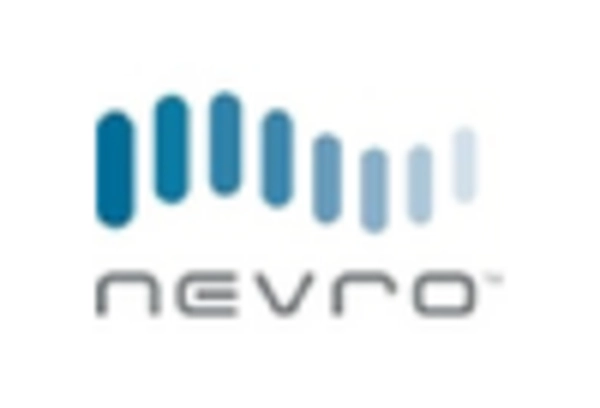Advancements in Medical Technology
Technological innovations in the field of neuromodulation are significantly influencing the spinal cord-stimulator market. Recent advancements include the development of closed-loop systems that provide real-time feedback and adaptive stimulation, enhancing the efficacy of pain relief. Additionally, improvements in battery life and device miniaturization are making spinal cord stimulators more appealing to both patients and healthcare providers. The market is projected to grow at a CAGR of around 10% over the next five years, driven by these technological advancements. As the spinal cord-stimulator market continues to evolve, the integration of cutting-edge technology is expected to play a crucial role in expanding its reach and improving patient outcomes.
Increasing Prevalence of Chronic Pain
The rising incidence of chronic pain conditions in the GCC region is a primary driver for the spinal cord-stimulator market. Conditions such as neuropathic pain, fibromyalgia, and failed back surgery syndrome are becoming more prevalent, leading to a growing demand for effective pain management solutions. According to recent estimates, chronic pain affects approximately 20% of the population in the GCC, which translates to millions of individuals seeking relief. This increasing prevalence is likely to propel the adoption of spinal cord stimulators, as they offer a minimally invasive alternative to traditional pain management methods. The spinal cord-stimulator market is thus positioned to benefit from this trend, as healthcare providers look for innovative solutions to address the needs of patients suffering from chronic pain.
Enhanced Patient Education and Support Programs
The spinal cord-stimulator market is also being driven by improved patient education and support initiatives. Healthcare providers in the GCC are increasingly focusing on educating patients about the benefits and risks associated with spinal cord stimulators. Enhanced support programs are helping patients make informed decisions regarding their treatment options. This increased awareness is likely to lead to higher acceptance rates of spinal cord stimulators among patients suffering from chronic pain. As the spinal cord-stimulator market continues to prioritize patient engagement, the overall growth and adoption of these devices are expected to accelerate.
Growing Investment in Healthcare Infrastructure
The GCC region is witnessing substantial investments in healthcare infrastructure, which is likely to bolster the spinal cord-stimulator market. Governments are prioritizing healthcare development, leading to the establishment of advanced medical facilities and specialized pain management centers. This investment trend is expected to enhance access to spinal cord stimulators, as more healthcare providers adopt these technologies. Furthermore, the increasing number of trained professionals in pain management is likely to facilitate the growth of the spinal cord-stimulator market. As healthcare systems improve, the availability and acceptance of spinal cord stimulators as a viable treatment option for chronic pain are expected to rise.
Rising Demand for Minimally Invasive Procedures
There is a notable shift towards minimally invasive procedures in the GCC healthcare landscape, which is positively impacting the spinal cord-stimulator market. Patients are increasingly favoring treatments that offer reduced recovery times and lower risks of complications. Spinal cord stimulators, being less invasive than traditional surgical options, align well with this demand. The market is likely to see a surge in adoption as more patients seek alternatives to invasive surgeries for pain management. This trend is indicative of a broader movement within the spinal cord-stimulator market, where patient preferences are shaping the development and marketing of new devices.

















Leave a Comment